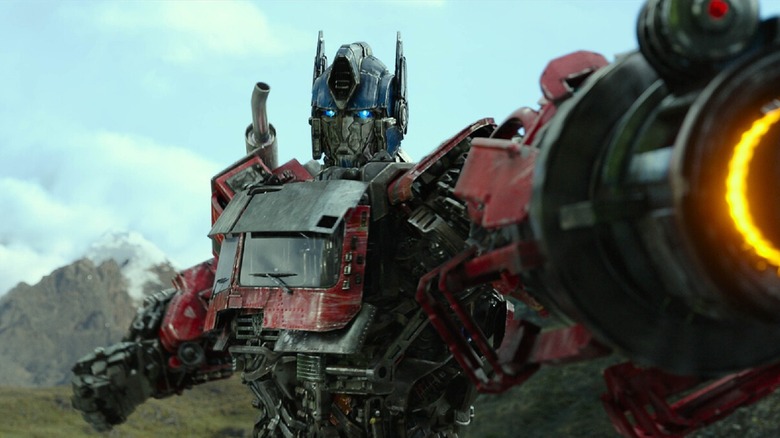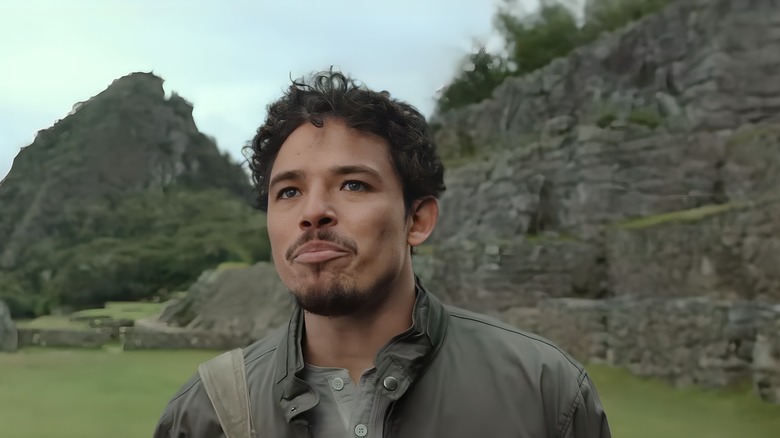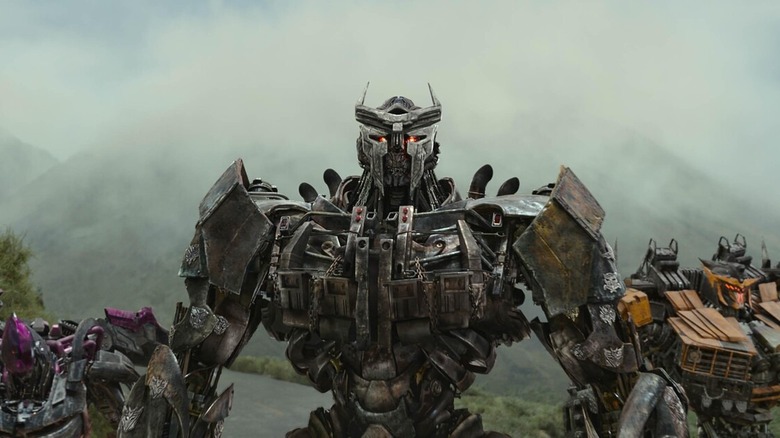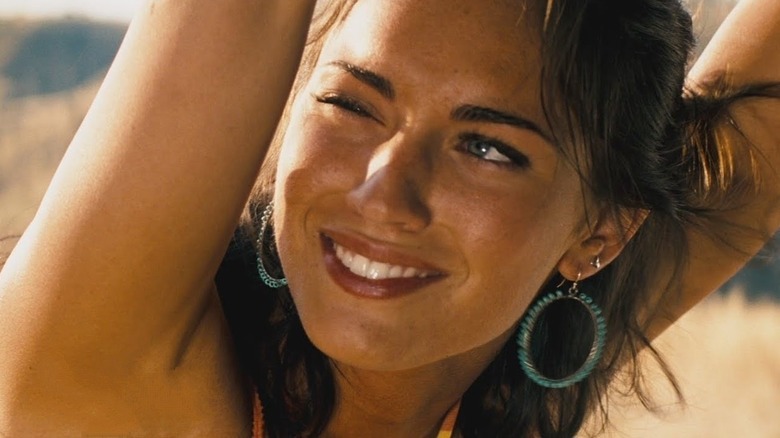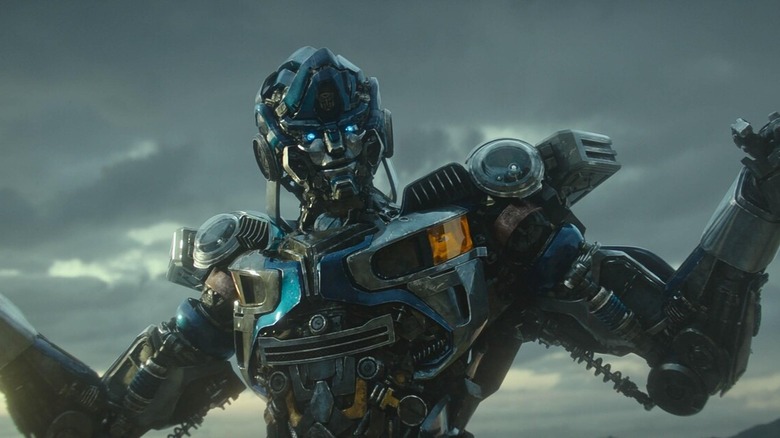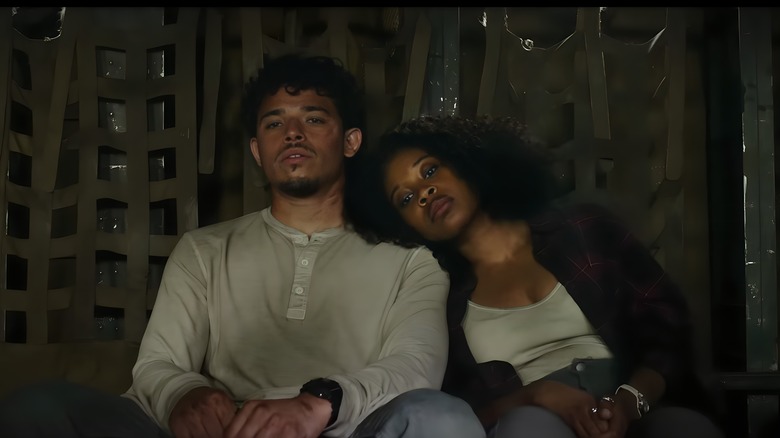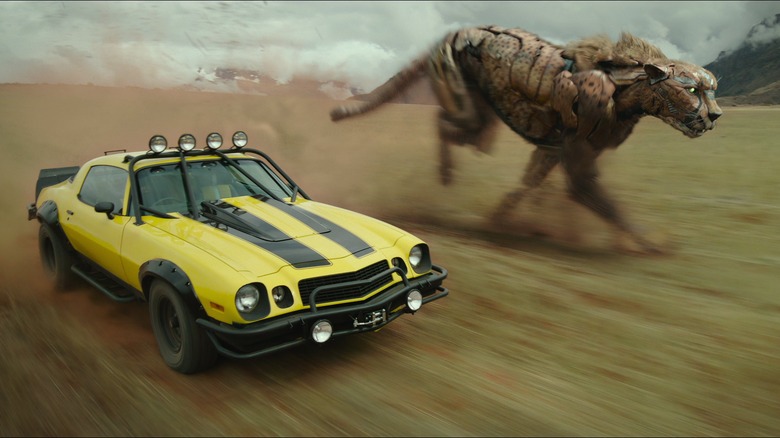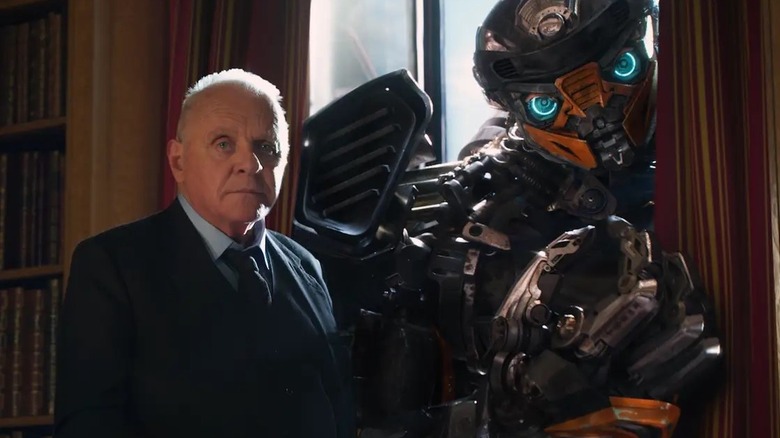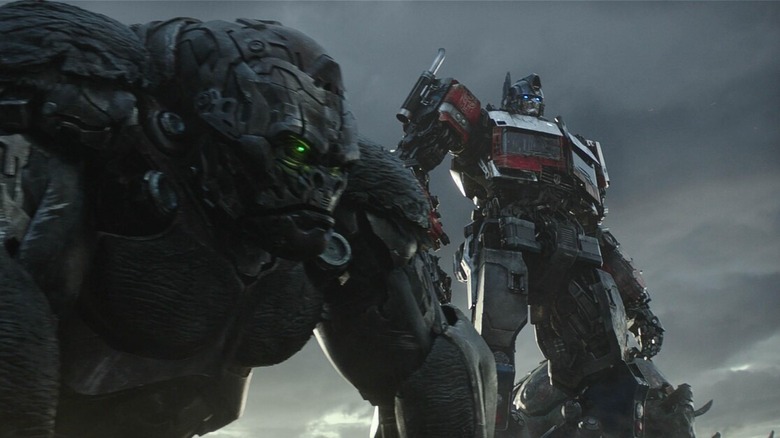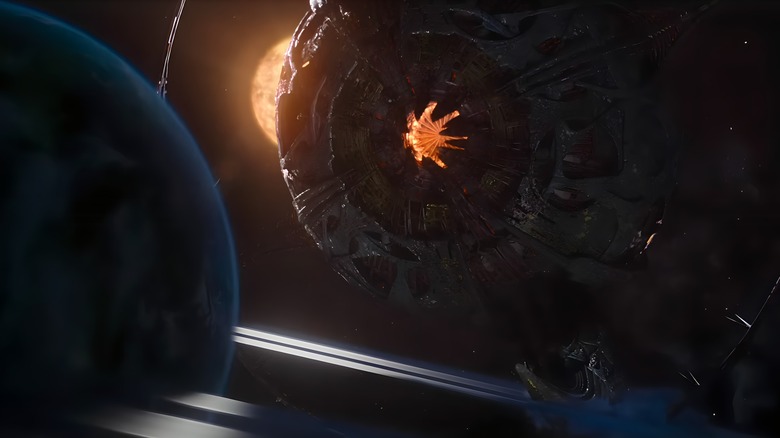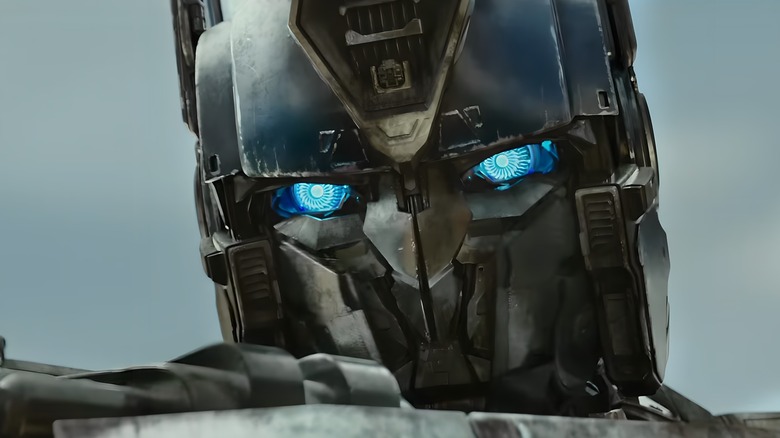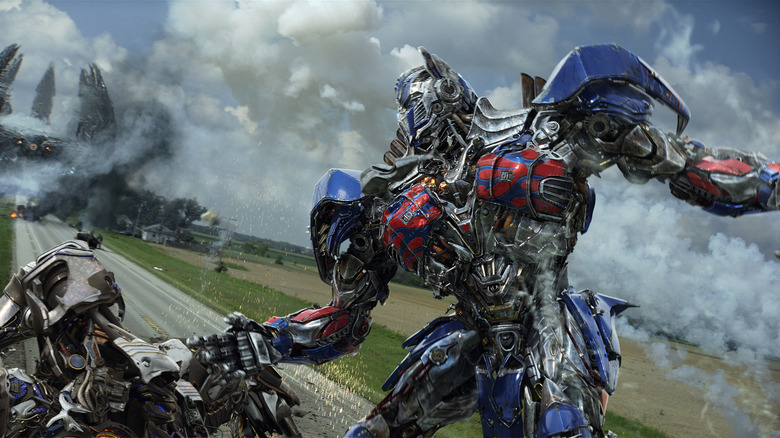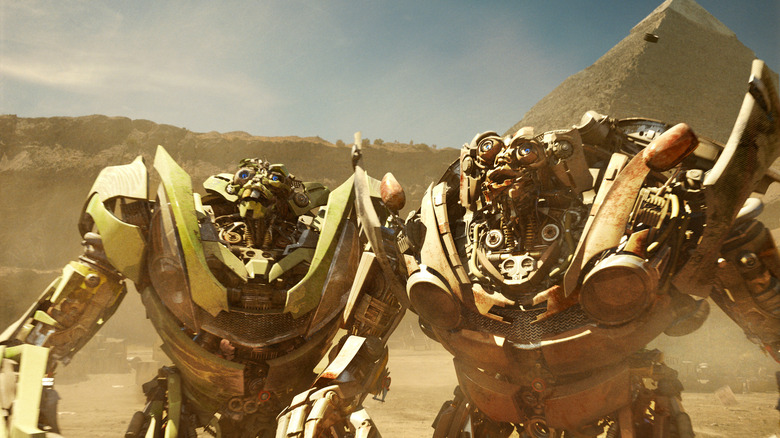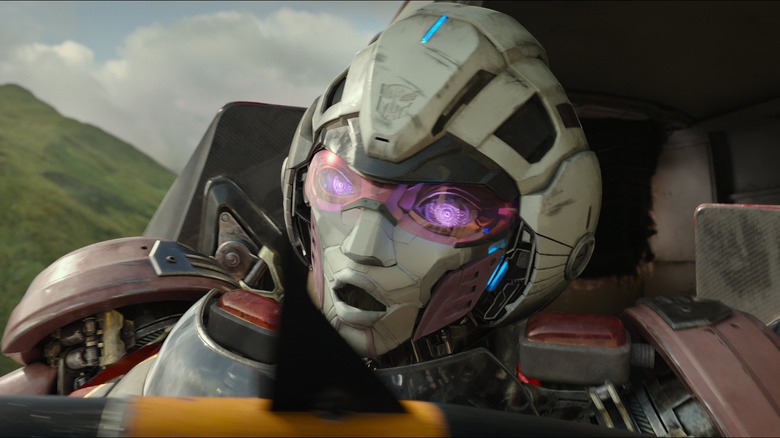Everything Transformers: Rise Of The Beasts Does Better (& Worse) Than The Michael Bay Movies
Now rebooted of sorts, the "Transformers" movie franchise will always live in the shadow of the original five "Transformers" titles directed by Michael Bay. Not only were they incredibly successful at the box office for the most part, but they had an influence on broader pop culture that's still reverberating through blockbuster cinema today. For good and for ill, Optimus Prime, Bumblebee, and the other notable Autobots will be forever informed by the aesthetic of titles like "Transformers: Revenge of the Fallen." The newest installment in the series, "Transformers: Rise of the Beasts," features several nods to those original movies — most notably maintaining live-action Optimus Prime's love for dispatching enemies through decapitations.
However — much like the 2018 prequel "Bumblebee" — it's also a project that tries to take the live-action incarnation of these robots in new creative directions. Those fresh ambitions lead to "Rise of the Beasts" unequivocally surpassing the Michael Bay "Transformers" movies in some key respects. Unfortunately, several aspects of "Rise of the Beasts" also end up coming up short compared to its predecessors – despite how torturous the original "Transformers" films could occasionally be. "Rise of the Beasts" attempts to provide a fresh start for this long-running franchise without totally abandoning the continuity and beloved elements of the "Transformers" saga, but how successful is it? We take a look at everything "Transformers: Rise of the Beasts" does better than the Michael Bay movies and the ways it falls short.
Better: Less aggravating human protaganists
The original "Transformers" movie was about a boy and his car — the boy being Sam Witwicky (Shia LaBeouf) — and the story of the original three "Transformers" films was largely told through his eyes. Starting from "Transformers: Age of Extinction," the point-of-view shifted to a more middle-aged perspective through Texas inventor Cade Yeager (Mark Wahlberg). These figures and their supporting players were never interesting, but worse than that, they were often surrounded by grating comedic relief players and the movies were overloaded with broad goofy caricatures mugging for laughs.
"Transformers: Rise of the Beasts" doesn't necessarily excel with its protagonists, but human leads Noah (Anthony Ramos) and Elena (Dominique Fishback) are far less annoying than Sam and Cade. "Rise of the Beasts" does a better job of intertwining Noah into the main robot action — though Elena is often given the cold shoulder — and over-the-top examples of comic relief human characters are kept to a bare minimum. Granted, there's still too much focus in this "Transformers" movie on disposable human beings instead of robots, but at least "Rise of the Beasts" has the good sense to make its humans more tolerable. Plus, none of them ever flash a laminated version of the Romeo and Juliet law, which instantly makes them a vast improvement on the humans in earlier "Transformers" adventures.
Worse: CG on the robots
With "Transformers: Rise of the Beasts," new visual effects ground has been broken for the franchise, and for the first time ever, the visual effects house Industrial Light & Magic is not involved with realizing the various CG robots. This company even stuck around with the Autobots and Decepticons through "Bumblebee," yet they weren't able to work on a massive movie like "Rise of the Beasts" with its slew of robots and mechanical animals. An assortment of different visual effects houses was instead recruited to realize the characters of "Rise of the Beasts," including Weta Digital, the New Zealand company famous for its work on "Avatar" and "Lord of the Rings."
Unfortunately, the CG used for the array of robots in "Rise of the Beasts" is not Weta's finest. The biggest issue is that Optimus Prime and company often look divorced from the live-action backdrops and strangely rubbery. A key climactic moment where the evil Scourge (Peter Dinklage) picks Noah up is undercut by just how fake the whole thing looks — the characters don't seem to be on the same planet, let alone in the same scene. This is in sharp contrast to the original "Transformers" movies, which featured terrible robot designs but did fine work incorporating the various aliens into real-world settings. Despite years of visual effects advancements since the first movie, "Rise of the Beasts" features shockingly subpar CG on its robotic leads.
Better: No weird objectification of female characters
When used correctly, sex in movies is awesome, and there's nothing better than a sensual atmosphere to deliver entertainment and insight into a character's psyche. Unfortunately, many mainstream films have a reductive view of what on-screen sexuality can be. A far cry from the presence of sex in the works of John Cameron Mitchell or Claire Denis, too many mass-market features have used "sexiness" as an excuse to dehumanize people rather than flesh out characters further. Case in point, the original Michael Bay "Transformers" movies, where the various lead ladies were all ogled by the camera in a very similar fashion that was more repulsive than titillating.
Performers like Megan Fox were just reduced to body parts for the enjoyment of the male gaze while their characters were never given interesting personalities or subplots to inhabit. It was a frustrating recurring problem in these movies that encapsulated the unimaginative approach many mainstream features have toward the concept of sexuality. Thankfully, "Transformers: Rise of the Beasts" avoids this problem with camerawork and editing that never reduces female lead Elena to being just something that people can drool over. Granted, it would have been even better if "Rise of the Beasts" had replaced this problem with a more thoughtful approach to sexuality rather than removing the element entirely, but at least the male gaze is toned down significantly.
Worse: More celebrity voice-overs
One unexpected virtue of the original Michael Bay "Transformers" movies was their heavy emphasis on professional voice actors to breathe life into the various robotic characters. Granted, this was a byproduct of the minimal screentime the Autobots and Decepticons initially had in these features, which likely made the idea of shelling out cash for famous voice actors a financially prohibitive idea. Still, it was cool that performers like Tom Kenny, Charlie Adler, and Frank Welker were the default picks for any Transformers in the live-action movies. Unfortunately, that tactic has largely been abandoned for "Transformers: Rise of the Beasts," which instead opts to cast celebrities for all the robots no matter how big or small the role is.
Not all the famous voices in this installment are inherently bad, with Michelle Yeoh's work as Airazor being one of the standout elements. However, it's puzzling that someone with the caliber of Colman Domingo was hired to voice just a handful of lines delivered by Unicron. Meanwhile, there's nothing in Liza Koshy's Arcee performance that couldn't have been accomplished by a professional voice actor like Cree Summer. Worst of all is Pete Davidson's performance as Mirage, which so overwhelmingly recalls the real-life version of Davidson that it proves distracting.
Better: Less jarring camerawork and editing
The Michael Bay "Transformers" movies were marked by the kind of frantic and hyperactive editing and camerawork choices that have become synonymous with this director. Combined with the often indecipherable designs of the various robots, many of the big action sequences were outright incoherent. 2017's "Transformers: The Last Knight" took things to an even lower low by employing a constantly shifting aspect ratio that would change from one shot to the next — a byproduct of the movie being partially shot with IMAX cameras. It was a headache-inducing element that cemented how unengaging the visual landscape of this franchise was.
Thankfully, "Transformers: Rise of the Beasts" opts for crisper framing, more brightly-colored robots, and more coherent images that make it easier to digest the various fight scenes. That doesn't mean there aren't unique visual defects in "Rise of the Beasts," especially when it comes to the often choppy editing in big set-pieces like the early car chase. However, at least the audience is always aware of what's happening in a single frame and isn't going to need a barf bag to get through a big battle sequence. Those two qualities alone put "Rise of the Beasts" heads and shoulders above the often incoherent installments like "The Last Knight."
Worse: More somber tone
It's incredibly welcome that "Transformers: Rise of the Beasts" avoids the lengthy stupid comedy that populated and weighed down Michael Bay's other movies. There aren't scenes derailed by derivative pot brownie shenanigans, for instance, nor are there characters like T.J. Miller's mechanic from "Age of Extinction" that seem to exist just to irritate the audience with misguided one-liners. However, "Rise of the Beasts" often opts for a strangely melancholy tone that can feel at odds with its more fantastical narrative impulses. Most notably, the screenplay is so concerned with apocalyptic stakes that the mid-movie reintroduction of the Maximals lacks any majesty or excitement. There isn't a moment for "Rise of the Beasts" to relish in a sense of glorious discovery over a mechanical gorilla. The movie is too preoccupied with the grim prospect of Unicron wiping out Earth and all its inhabitants.
The lore-heavy plot treats everything with such seriousness that all the potential fun of a premise involving mechanical jungle critters is never realized. "Rise of the Beasts" is most certainly not devoid of comedy or immersed in gritty reality, but it's often so self-conscious about not repeating the grating comedy of the earlier "Transformers" titles that it lapses into being overly formal. Surely there was a better middle ground between Wheelie humping Megan Fox's leg in "Revenge of the Fallen" and the often needlessly subdued tone of "Rise of the Beasts."
Better: More interesting needle drops
Needle drops of existing tunes were quite common in the original "Transformers" films, but they often just employed popular ditties from famous rock artists in the 2000s. Green Day, Staind, and Nickelback were all on the soundtrack for "Transformers: Revenge of the Fallen," for instance, while Linkin Park delivered a bunch of original tunes for the Michael Bay "Transformers" movies. Meanwhile, Imagine Dragons came up with an incredibly forgettable song called "Battle Cry" that played at various moments throughout "Transformers: Age of Extinction." Needless to say, the approach of the Michael Bay "Transformers" movies to needle drops was to utilize then-hot artists who could give these titles an extra dash of coolness. You could hear the marketing executives molding these soundtracks rather than any sincere musical inclinations of the people behind these movies.
"Transformers: Rise of the Beasts" uses several vintage needle drops to hammer home that audiences are watching a movie set in 1994 and they're an incredible breath of fresh air. Instead of Imagine Dragons and Nickelback, we have the Nas song "Represent," and "Check the Rhime" by A Tribe Called Quest. There's even a thrilling use of "Mama Said Knock You Out" by LL Cool J underscoring one of the big crowdpleaser moments of "Rise of the Beasts." Needless to say, the musical sensibilities of "Rise of the Beasts" are one of the clearest ways it improves on its predecessors.
Worse: The overqualified dramatic supporting actors are missed
One weird fixture of the Michael Bay "Transformers" movies was how these lengthy toy commercials — that represented so many toxic impulses of mainstream American cinema — also attracted such prestigious performers for key supporting roles. After John Turturro played Seymour Simmons in the original "Transformers," the subsequent installments in this series kept finding roles for comically overqualified actors to inhabit. Frances McDormand showed up in "Transformers: Dark of the Moon" as a stern government official while Anthony Hopkins is around in "Transformers: The Last Knight" as a guy who, among other feats, yells at tourists exploring a submarine and inquires about Mark Wahlberg's sex life.
These actors were never delivering their greatest works in the "Transformers" movies, but there was an undeniable level of morbid entertainment to be had in watching such legendary performers navigate the nonsensical balderdash of these features. Unfortunately, "Transformers: Rise of the Beasts" never even tries to emulate this quality of the earlier "Transformers" titles, with the live-action supporting cast being devoid of any unexpected legendary actors. The absence of, say, Al Pacino chatting it up with Optimus Primal doesn't inherently make "Rise of the Beasts" a bad movie. However, the dissonance of actors like Hopkins sharing the frame with characters like Hot Rod was amusing enough to make it deeply missed when it's suddenly gone from the franchise.
Better: More distinctive robot designs
Go back and look at the designs of the robots in the original "Transformers" movies and try your hardest to discern who is who. Across the original trilogy of "Transformers" films, the default color scheme for the Decepticons was grey and black, making it impossible to tell Soundwave from Starscream. The Autobots had more varied color palettes, but their over-designed appearances made it impossible to figure out simple, yet crucial details about the characters, like where their heads were. While "Transformers: Age of Extinction" and "Transformers: The Last Knight" tried to streamline the robot designs and utilize more primary colors in their looks, they were still largely unimaginative and often blended together in chaotic action sequences.
"Transformers: Rise of the Beasts," thankfully, opts for much more simplified robot designs. Villainous characters like Scourge are still decked out in subdued colors, but it's much easier to discern the anatomy of individual robots while the various Maximals are extremely distinctive-looking compared to one another. It's also a pleasant surprise to see characters like Arcee and Mirage have such vibrant hues, while even the villainous Nightbird gets a pleasing purple color scheme. While not quite as pleasing-looking as the very classical designs seen in "Bumblebee," the designs of the Transformers in "Rise of the Beasts" are a welcome departure from the older "Transformers" features.
Worse: Rise of the Beasts fails to take advantage of its period setting
Much like "Bumblebee," "Transformers: Rise of the Beasts" is a period piece. This time around, the Transformers are shown interacting with Earth and its people in the year 1994. Initially, director Steven Caple Jr. seems quite keen to emphasize that "Rise of the Beasts" is very much in tune with the world of 1994 thanks to elements like kids wearing "Mighty Morphin' Power Rangers" T-shirts. However, as the story goes on, the 1994 setting becomes increasingly inconsequential to the movie. By the time the action shifts to Peru and focuses on stopping the arrival of Unicron, "Rise of the Beasts" could be set in any time period.
This is a disappointing element of the movie, but it's especially strange since the Michael Bay "Transformers" movies were, for good and for ill, very much rooted in the time periods they were made in. The first "Transformers" in 2007 featured a barely-concealed caricature of George W. Bush, while the imagery of Chicago being decimated by the Decepticons in "Transformers: Dark of the Moon" was all about evoking post-9/11 trauma, 10 years after the national tragedy. With so many other instances of the "Transformers" movies being rooted in very specific eras, it's a pity "Rise of the Beasts" quickly loses interest in making use of its 1994 setting.
Better: Shorter runtime
Michael Bay movies have never been known for brevity. A film where Bruce Willis has to blow up an asteroid runs 150 minutes for some reason while the romantic epic "Pearl Harbor" exceeded three hours in length. Unsurprisingly, even when Bay began making movies based on toy robots, this filmmaker didn't abandon his love for features that tested people's bladders. The original "Transformers" exceeded 145 minutes and the sequels only got longer from there. The peak runtime of the saga was reached with the 2014 installment "Transformers: Age of Extinction," which ran for a staggering 165 minutes. A motion picture concerning robotic dinosaurs wrecking shop against mean aliens had the same runtime as fellow 2014 movie "Boyhood," which chronicled 12 years of human existence.
Thankfully, "Transformers: Rise of the Beasts" is one of the shortest live-action "Transformers" movies at just 117 minutes. Even though it's much shorter than "Transformers: The Last Knight," "Rise of the Beasts" certainly could've withstood some further cuts in the editing room, particularly in a slow second act that is far too heavy on exposition. Pacing issue notwithstanding, though, the length of "Rise of the Beasts" is an incredibly welcome deviation from the runtime norms of the Michael Bay "Transformers" movies.
Worse: Rise of the Beasts emphasizes silly sequel and cinematic universe set-ups
The first "Transformers" movie was released five years before "The Avengers" popularized shared universes and Michael Bay's career as a blockbuster auteur began nearly two decades before that Marvel Studios feature. Because of this, Bay's approach to big-budget movies and "Transformers" has never really included rampant sequel teases. His "Transformers" movies could feature lingering plotlines to be dealt with later — like the retreat of Starscream into space in the initial "Transformers" or the cliffhanger ending of "Transformers: Age of Extinction" — but typically, his works functioned as standalone enterprises. They were interested in the here and now rather than teasing endless spin-offs.
The ending of "Transformers: Rise of the Beasts," unfortunately, makes the open-ended conclusion of "Age of Extinction" look extremely subtle by comparison. This ending suddenly introduces the G.I. Joe mythos into the world of "Transformers" in the hopes of kickstarting a new Hasbro Cinematic Universe. While it's a prospect that likely made Paramount Pictures and Hasbro executives clap their hands in glee, it's an incredibly awkward ending that harkens back to the days of the Dark Universe and other misguided stabs at cinematic universe storytelling. It's also an unwelcome departure from the willingness of earlier "Transformers" movies to at least end on a definitive note rather than retroactively turn a preceding movie into a feature-length trailer.
Better: Fewer attempts at being edgy
From the very beginning, the Michael Bay "Transformers" movies didn't want to be seen as just family movies. As a result, these features bolstered their respective screenplays with plenty of apparently edgy humor meant to tell adults in the audience that this was a movie meant for them. Whether it was a lengthy — and misguided — gay panic joke in "Transformers: Dark of the Moon" or an extended awkward conversation between Sam Witwicky and his parents in the first "Transformers," the Bay take on these characters was packed with pervasive edginess. This inclination towards provocative humor even underscored the presence of the infamous Twins characters in "Transformers: Revenge of the Fallen." This pair of robotic characters functioned as obvious racist caricatures that proved uncomfortable, not humorous.
Taking a cue from the creative impulses of "Bumblebee," "Transformers: Rise of the Beasts" eschews tendencies towards crudeness and shallow ideas of adult humor. While the film doesn't talk down to audiences or prove totally unengaging to older viewers, it happily proves appropriate for younger viewers to watch. It also doesn't derail its plotline with weird attempts to prove how mature its sense of humor is, which helps make the pacing far more consistent. Ironically, by avoiding edgy humor aimed at grown-ups, "Rise of the Beasts" comes off as a far more mature and confident production.
Worse: Adherence to realism makes even less sense in Rise of the Beasts
The early "Transformers" movies appeared a little self-conscious when it came to embracing every corner of the source material, but there is a slight shift in "Transformers: Rise of the Beasts." Female Transformers like Arcee, for instance, were initially abandoned in these movies because the writers didn't want to explain how gender works among robots, but she has a much bigger role in this latest installment.
The very presence of the Maximals in "Rise of the Beasts" suggests that the franchise has moved closer to acknowledging the ridiculous parts of Transformers lore. Unfortunately, the more ridiculous parts of "Rise of the Beasts" underscore how the rest of the movie is still too devoted to realism. Human beings still get the lion's share of screentime instead of the titular robots, major robots like Unicron are still drained of the primary colors they have in the comic books, and too much time is spent on trying to provide rational explanations for story elements like why the Maximals are on Earth. The "Transformers" movies still feel self-conscious enough to overwhelm the audience with exposition justifying its outlandish qualities, which just feels like an extra strange maneuver when there's a robot gorilla stomping around on-screen.
